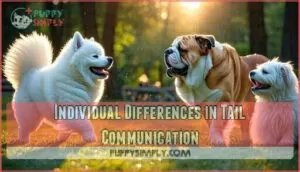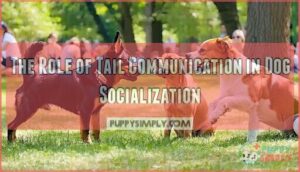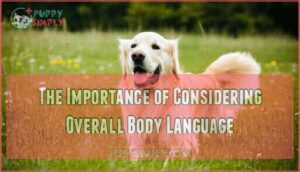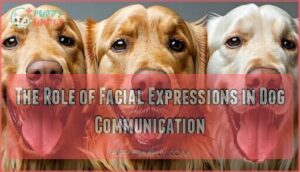This site is supported by our readers. We may earn a commission, at no cost to you, if you purchase through links.

A relaxed, sweeping tail says "all is well," while a stiff, high tail might mean your pup’s feeling bossy or uneasy.
If their tail is tucked like they’re hiding a secret, that’s usually fear or stress talking.
Fast, wide wags can mean happy anticipation, like when you grab the leash for a walk.
Remember, a wag doesn’t always mean “friendly”—it’s all about context.
Pair those tail moves with their ears and face, and you’ll start reading your furry friend like a pro.
Curious about more hidden dog cues?
Table Of Contents
- Key Takeaways
- Understanding Dog Tail Language
- The Meaning Behind Tail Wagging
- Interpreting Tail Positions
- Individual Differences in Tail Communication
- The Role of Tail Communication in Dog Socialization
- The Importance of Considering Overall Body Language
- The Role of Ears in Dog Communication
- The Role of Facial Expressions in Dog Communication
- Using Tail Language to Enhance Your Bond With Your Dog
- Frequently Asked Questions (FAQs)
- How do you read a dog’s tail?
- How do you read a dog’s body language?
- How do you know if a dog has a tail wagging?
- What is dog tail language?
- Why is dog tail language so important?
- What is a dog body language chart?
- What do tail positions mean for dogs?
- What does it mean when a dog’s tail is high?
- Do different tail wags mean different things?
- How do tail injuries affect dog communication?
- Conclusion
Key Takeaways
- Watch your dog’s tail position and movement—high and loose wags usually mean happiness, while tucked tails signal fear or stress.
- Don’t assume a wag always means friendliness; context, speed, and stiffness of the wag reveal different emotions like excitement, anxiety, or dominance.
- Pay attention to ear position and facial expressions along with the tail; reading the whole picture gives you the clearest sense of your dog’s mood and emotions.
- Breed differences and individual quirks mean every dog “speaks tail” in their own way, so take time to learn your pup’s unique signals and cues.
Understanding Dog Tail Language
Ever wonder what your dog’s tail is really saying? Understanding dog tail language is a bit like learning a new dialect—full of wagging signals and subtle hints.
From curly puppy tails to the sleek flags of adults, each movement tells a story. Breed variations and docked tails can change how clear those signals are, so don’t worry if things get lost in translation now and then.
Pay attention to the tail’s position, speed, and shape. Puppy tails might twitch with curiosity, while stiffer tails could mean worry or alertness.
Everyone’s got that friend who “talks with their hands”—for your dog, it’s their tail that reveals the full emotional range. Watch, learn, and you’ll soon speak fluent tail.
Your dog’s tail is their voice—master their signals and you’ll unlock a whole new level of connection.
The Meaning Behind Tail Wagging
When you see your dog wagging its tail, don’t assume it always means happiness—sometimes, that wag is saying much more.
By paying attention to tail speed, position, and context, you’ll start to pick up on what your pup is really feeling, even if he’s just spotted the mailman, and understand that the wag can signify happiness or other emotions.
Happy Tail Wagging
When you spot a happy dog tail cutting broad, sweeping movements through the air, your pup’s sharing pure joy.
Relaxed posture, loose muscles, and a playful intent scream dog happiness.
In most social contexts, these dog tail wags mean your buddy’s thrilled, maybe saying hello or inviting you to play.
Of course, breed variations play a role—some tails curl, some are straight—but the signals stay the same: soft, rhythmic, friendly.
Spotting a happy dog tail wagging is your best clue that everything’s right in their world.
Anxious or Aggressive Tail Wagging
Not all wags mean your dog’s happy. After seeing that joyful tail swing, you’ll sometimes run into the Stiff Tail—a warning flag in dog body language.
A rapid, tense wag can turn a friendly moment prickly, especially if the Hackles are Raised. When your dog flashes a Defensive Wag, pay extra attention, as Context Matters.
Every breed has its quirks, so what’s aggressive in a German Shepherd might just be alertness in a Beagle. Unsure what you’re seeing? Keep an eye out for these signs:
- Raised, stiff tail with a locked-in stare.
- Tail wagging flat and rigid, often paired with slow movement.
- Hackles up, body tense, and a low growl—or radio silence.
Reading dog tail wags keeps everyone safer.
Interpreting Tail Positions
When you see your dog’s tail held high or tucked between their legs, you’re getting an honest peek at how they’re feeling.
Reading these tail positions helps you understand if your pup is feeling brave, worried, or just unsure if the mail carrier is friend or foe, which gives you a glimpse into their emotional state and allows you to respond appropriately.
Tail Held High
You’ll often notice your dog’s tail standing tall, waving like a flag.
That upright tail isn’t just for show – it’s a billboard for excitement levels, dominance display, or even alertness signals.
If the wag is loose and relaxed, your pup’s probably keen to play.
But when the tail’s stiff and held high, you might want to watch for potential aggression, especially in new situations.
Breed variations play a role, too—think of Huskies with their curly tails.
A dog’s body language is rarely one note; always pair tail signals with ear and facial cues for the clearest dog communication.
| Tail Position | Mood |
|---|---|
| Relaxed & High | Confident/Happy |
| Stiff & High | Dominance/Aggression |
| Slightly Raised | Alertness |
| Naturally Curled | Breed Variation |
Tail Tucked Between Legs
Seeing a dog with its tail tucked between the legs can tug at your heartstrings—it’s a classic dog body language move that speaks to fear and anxiety. But don’t jump straight to submission signals. Context matters.
Some breeds naturally have lower tails, while others do this when cold or feeling unwell. Watch closely for dog tail signs like trembling, panting, or avoiding eye contact. A tucked tail is a strong indicator of potential fear or anxiety, so observing the dog’s overall body language is essential.
To comfort an anxious dog, consider the following steps:
- Remove loud noises or unfamiliar triggers nearby.
- Offer soothing words or treats—think of it as canine comfort food.
- If tail tucking sticks around, check for medical causes or pain.
Knowing the nuances helps you comfort an anxious dog with confidence. This understanding is key to providing the right support and care for a dog exhibiting signs of anxiety.
Individual Differences in Tail Communication
Next time you’re observing dog tail wagging, notice how breed variations, docked tails, age influence, and learned behaviors create unique signals for each pup.
Just as some folks talk with their hands, every dog has personal quirks in their dog body language. A high wag might mean playfulness for one, but for another, cautious curiosity.
Age and experience add layers to canine communication, and these individual differences make interpreting dog communication part science, part art—so get to know your buddy’s tail talk up close! Understanding a dog’s tail wagging meaning can help you better interpret their feelings.
The Role of Tail Communication in Dog Socialization
Tail talk is a social glue in playgroup dynamics, making up much of dog communication during greetings and group interactions. Dogs wave their tails in ways that broadcast if they’re cool with newcomers or staking claim to that favorite stick.
You’ll see socialization cues play out in every wag, bow, and “is this dog friend or foe?” stare-down. Understanding these signals prevents mix-ups—one stiff tail may mean “back off,” while a fast, loose wag says “welcome!”
Here are five things to notice during dog socialization:
- High, confident tails may signal dominance.
- Low or tucked tails often mean submission or anxiety.
- Broad wags usually indicate friendliness.
- Stiff, slow wags can warn of aggression.
- Breed variations and early experiences shape tail language.
Getting a read on your dog’s communication style builds trust and harmony. Early socialization can prevent fear-based aggression.
The Importance of Considering Overall Body Language
Your dog’s body is like a living emoji, each part telling a bit of their story.
Reading dog body language goes beyond tail positions—think of it as Holistic Interpretation, where everything matters.
You’ll want to notice Facial Cues, how your dog holds their ears, their posture, and even the tone of their barks.
For example, a wagging tail paired with tense posture or “whale eye” (the whites of their eyes showing) points to nerves, not joy.
Context Matters: a happy greeting looks different from a nervous one, even if both include wagging.
Posture Analysis adds another layer, helping decode canine behavior and emotions in real time.
By tuning into these dog body language signals, you’ll build better Canine Communication and a closer bond with your pup.
The Role of Ears in Dog Communication
You might think a wagging tail tells the whole story, but your dog’s ears are just as important for understanding how they feel.
Watch their ear position closely, because it can quickly clue you in when they’re excited, curious, or a little unsure.
Ears Back
Just like reading a friend’s expression, understanding a dog’s ears back can open a window into their emotions. You might notice those “fearful ears” when a pup feels unsure—think of it as their way of offering a polite “I’m not sure about this.”
If their tail’s low and the wag is slow, they’re probably sending out a mix of submissive signals and calming signals. While some breeds wear their ears like floppy hats, others have perkier “aural health” cues.
Consider added ear assistance if your dog’s ears are causing them discomfort. Keep an eye out for these telltale signs:
- Ears pinned tightly against the head (often fear or submission)
- Ears softly pulled back with a relaxed body (friendly or seeking affection)
- Subtle flicks in response to sounds (environmental alertness)
- Ear positions paired with different dog tail positions
Understanding these tweaks helps you read dog body language and deepen your bond.
Ears Pointed Up
When you spot those ears pointed up, you’re seeing your dog’s built-in radar at work—this classic Alertness Indicator signals a sharp awareness of the world.
Maybe it’s a squirrel rustling in the bushes or a pizza box being opened three rooms away; those impressive ears, with finely tuned musculature, pick up on sounds we’d never notice.
Dogs use ear position, just like tail movement, to send clear dog signals about their mood and focus. You’ll notice different Breed Variations—some dogs have floppy ears that perk up just a bit, while others have upright, alert triangles.
Either way, pointed-up ears mean their Hearing Acuity is dialed in. It’s not just about listening, though. Pair this with body language like hackles or dog tail positions for the full story.
Keeping an eye on Aural Health lets your pup’s signals shine.
The Role of Facial Expressions in Dog Communication
Peering into your pup’s face offers a goldmine of clues about canine communication. Those Facial Muscles work overtime: Eye Contact can reveal trust or a dash of daring, while relaxed lids hint at comfort.
A dog’s face is an open book—every twitch of muscle shares a secret about their heart.
Notice Mouth Expressions—panting with lips slightly parted usually means happiness, but a tight-lipped grin could spell stress. Brow Movement is a dead giveaway, too; furrowed brows create Wrinkles Meaning confusion or worry.
Pay attention—these facial expressions are the “text messages” of dog body language. Decoding dog emotions through their facial cues helps you navigate everyday dog behavior with more empathy and understanding.
Understanding these cues is especially important when observing potential signs of territorial aggression.
Using Tail Language to Enhance Your Bond With Your Dog
A single glance at your pup’s tail can tell you a boatload—if you know what to look for.
Tail communication training is key to a strengthened emotional connection and mutual understanding with your furry friend. Interpreting dog tails isn’t just for the pros; you can spot dog tail meanings right at home. Here’s how to use dog tail body language to boost your bond:
- Watch for changes in tail speed, height, and direction. A slow wag low to the ground signals uncertainty, while a high, fast tail might mean excitement—or trouble brewing.
- Pause before jumping into play. Take a moment to observe their mood.
- Try tail-based games or positive reinforcement to build trust.
- Notice behaviors like cowering or lip licking, which hint at anxiety.
- Check their ears. Upright shows interest, flattened can mean nerves.
With practice, decoding canine communication becomes second nature—and helps turn you and your dog into a real team.
Frequently Asked Questions (FAQs)
How do you read a dog’s tail?
Watch your dog’s tail—the higher and looser it wags, the happier they are; a tucked tail signals fear or anxiety.
Each wag tells a story, so read the whole “book,” not just the cover.
How do you read a dog’s body language?
Read your dog’s body language by noticing their ears, tail, posture, and facial expressions.
A relaxed stance means calm, while stiff limbs or wide eyes can signal stress.
Trust your gut; your pup’s signals rarely lie, and it is crucial to notice these signals to understand your dog’s emotions.
How do you know if a dog has a tail wagging?
Picture a cassette tape rewinding—if your dog’s tail moves back and forth, that’s wagging.
You’ll spot the motion easily, whether it’s slow or fast, often paired with a relaxed body or even a happy dance.
What is dog tail language?
Dog tail language is like a doggy Morse code—every wag, curl, or tuck shares their feelings.
You’ll see joy, worry, or even sass, all told through tail position, speed, and direction.
Pay attention!
Why is dog tail language so important?
Funny how tails do the talking when words don’t work, right?
When you understand tail language, you spot fear, excitement, or stress in your pup.
This insight helps you respond quickly, building trust and connection.
What is a dog body language chart?
A body language chart helps you decode your pup’s mood—like a cheat sheet for their wagging, wiggling, or tail tucking.
It uses quick visuals and tips so you can spot emotions before barking up the wrong tree, which can be considered a cheat sheet.
What do tail positions mean for dogs?
They say, actions speak louder than words—so do tails.
When your pup holds its tail high, it’s excited or alert.
A low or tucked tail means it’s anxious or uncertain.
Middle position? That’s calm contentment.
What does it mean when a dog’s tail is high?
When you spot a tail held high, your pup’s brimming with confidence or excitement.
Think of it like a flag—sometimes it signals playfulness, and other times it’s a polite “heads up, I might react!”
Do different tail wags mean different things?
Ever wonder if your dog’s tail has its own secret handshake?
Well, it does!
Fast wags can show excitement, but stiff or low wags might mean nerves.
Pay attention—tail talk reveals what your pup’s truly feeling.
How do tail injuries affect dog communication?
When a dog injures its tail, you might notice their “tail talk” falls flat.
That wag or position just doesn’t send the usual signals, so misunderstandings can happen with other dogs or even with you.
Conclusion
Just like reading a book by its cover can be misleading, understanding how to read dog tails body language opens up a whole story beneath the surface.
When you spot those wags, positions, and pair them with ear and facial cues, you’ll start grasping your dog’s message clearly—no superpowers needed.
Remember, every pup has their own dialect, but with attention and practice, you’ll decode their “tail talk” and strengthen your bond, one wag at a time, which is a key part of understanding your dog’s message.
- https://oceanservice.noaa.gov/facts/oceanwater.html
- https://dog-house.ae/dogs-physical-health/understanding-dogs-tail/
- https://tuffpets.co.uk/blogs/pet-blogs/what-does-a-dog-with-its-tail-between-its-legs-mean
- https://bestfriends.org/pet-care-resources/dog-body-language-signs-comfort-stress-and-more
- https://www.animalwellbeingcentre.com/blogs/tucked-tail-does-it-really-mean-a-dog-is-afraid
















